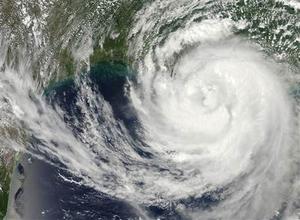Hurricane Isaac updateAs Hurricane Isaac beats on New Orleans, new infrastructure is holding up
This week, as Hurricane Isaac was threatening to replicate the physical damage that Katrina inflicted, it has become apparent that $14 billion worth of changes and improvements in infrastructure, planning, and emergency response procedures have given the city of New Orleans and the Gulf states the ability to withstand the worst of the storm

NASA photo showing Hurricane Isaac approaching New Orleans // Source: yahoo.com
Seven years ago this week, New Orleans residents lost their homes, and many lost their lives, as Hurricane Katrina beat down the fun-loving city. It took billions of dollars and thousands of hours to get the city back up and get people to get over the tragedy.
Hurricane Isaac (downgraded to a tropical storm on Wednesday) hit Louisiana, as well as Mississippi, Arkansas, Texas, and Florida, with 60 mph winds, and more than ten inches of rain in some spots. FEMA reports power outages throughout five states and much of the economic life around the Gulf Coast is largely shut down.
This week, as Hurricane Isaac tries to replicate the physical damage that Katrina inflicted, it has become apparent, Engineering News-Record reports, that $14 billion worth of changes in infrastructure, planning, and emergency response procedures have given the city more than just a fighting chance to withstand the worst of the storm.
Communications are faster, leadership is more balanced and effective, and citizens are more aware and prepared for the dangers; they know where to go to get the latest updates, and where to go if they have to abandon their homes.
In a statement on its Web site, the New Orleans District of the U.S. Army Corps of Engineers says the Hurricane and Storm Damage Risk Reduction System (HSDRRS) is performing as designed during what is turning into an extended load test.
The HSDRRS sprawls across five parishes and consists of 350 miles of levees and floodwalls, seventy-three non-federal pumping stations, three canal closure structures with pumps, and four gated outlets. During most of Wednesday and Thursday, the new levees, pumps, and support systems have been doing their jobs, according to officials.
USA Today reports that the one setback was the low lying Plaquemines Parish, which had its levees overtopped with water, hitting the area with more floods than residents saw during Hurricane Katrina. The storm is moving very slowly so the city and surrounding states are not out of trouble just yet.
Isaac has done considerable damage, but that way the city of New Orleans and the state of Louisiana have coped show considerable improvements over what happened seven years ago during Hurricane Katrina. The United States as a whole, however, is still unprepared for most natural disasters.
In 2009 the American Society of Civil Engineers (ASCE) gave U.S. infrastructure a D in the most recent assessment of bridges, roads, public transportation, and water systems.
According to the assessment, one-third of the country’s major roads are in poor or mediocre condition, and more than a quarter of the country’s bridges are ”either structurally deficient or functionally obsolete.” New Jersey holds the dubious distinction of being one of the nation’s leaders in deficiencieswhen it comes to being prepared for Katrina-like events.
Many of the estimated 100,000 miles of levees in the country were originally built to protect crops, but now many are used to protect communities, and it is unclear whether theyare reliableenough for that task. Just last week, levees protecting most of Sacramento and other parts of California’s Central Valley were declared to have failed federal maintenance criteria.
Most local governments find it difficult, in times of scarce resources, to allocate funds for protection against one-time or very rare events. In recent years, however,the number of catastrophic events, and their intensity,haverisen, so more states and communities are faced with a choice of spending millions to get themselvesprepared now, or possibly spending billions after the fact.
